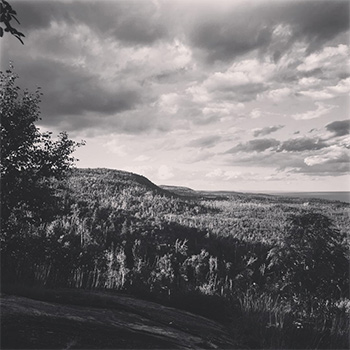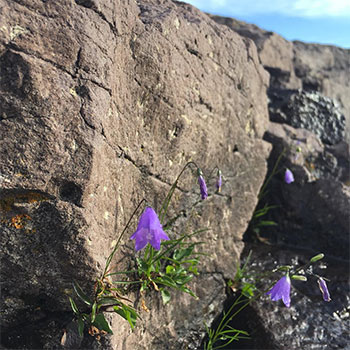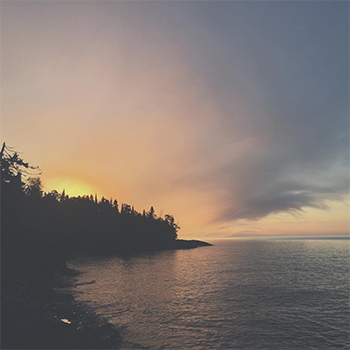Subtotal: $
Checkout
A rustling beneath me – Matthew was rummaging in his pack. It was near midnight. He pulled out his rain fly, crawled back into his hammock, and wrapped the fly around his whole body and over his head. Suspended a few feet above him between two birches, I felt a bit satisfied that I had packed a long-sleeve shirt and was not feeling the least bit chilly. It was probably half an hour before I was padding around in the dirt in my socks, trying to undo my own rain fly and putting on every piece of extra clothing I had. Another hour after that my toes went numb, and then my whole feet, and then a night of shivering. Sleep made the briefest of cameo appearances.
It was July, and July is not cold. We had expected warm, humid nights under the stars. The North Shore of Lake Superior offered instead a crisp, windy forty to fifty degrees at night. That does not seem so bad when you are bringing the garbage cans to the curb for pick-up, but in a paper-thin nylon sack blowing in the wind for eight hours, it is rather brisk.
After a return to Duluth to purchase a few more layers and some cheap blankets, we were back on the trail and slogging through muddy low country in one of the rainiest summers in memory. It was a boggy purgatory of mosquitoes and horseflies, old cut-down logging operations, cracked, ankle-breaking shale underfoot, and constant hills. The only reward we were afforded was a little spot with the marker “twelve-mile view,” which was a tiny gap between two trees and – what exactly? Maybe a lake in the distance? It was too hard to tell.
On the last day of this first leg of the journey, we were going to push ourselves to an eighteen-mile hike over a lot of elevation changes and set up camp about twelve miles inland from Two Harbors. On what must have been mile seventeen, we were hit by a sudden squall with horizontal sheets of rain, and when we sludged into camp, we found that all our gear was soaked clean through. We had skimped on dry sacks. It was apparent, even while every mosquito God ever created was filling up at the Nathan and Matthew buffet, that with wet clothes and blankets there would be no question of sleeping out in the cold woods.

Photographs courtesy of the author.
Blister-footed and thigh-chafed, leg-tired and soggy, we stepped slowly back down the muddy trail, headed toward an old logging road in the hopes that someone would pass by. Eventually, someone did, but wouldn’t take us. Finally, the hum of an old engine bounced among the trees as daylight began to falter through the leaves. I waved down the truck. A bit hopeless, I asked if there was any chance that the driver could give us a ride. He gladly obliged, threw our bags in the back, moved the twelve-pack of beer he was working on out of the passenger seat (cheerfully assuring us that sipping on these backroads was “legal”), and brought us to a hotel.
Having hiked some twenty-six miles over constant elevation changes with forty-pound packs (smart college lads that we were, we hadn’t really trained or conditioned for this), sore and covered with mosquito bites, we booked a room and collapsed into delicious luxury: a shower and clean sheets.
That was one of my favorite days. The whetstone of lack sharpens the soul for the experience of fullness. This trip would afford sublime views, the gift of solitude, and the quiet and natural rhythms of an empty wood. Still more, the trail shocks the senses into realizing the gratuity and luxury of mattress, shower, and clean clothes, and awakens the mind to the pleasure of working legs, pumping lungs, and seeing eyes.
The whetstone of lack sharpens the soul for the experience of fullness.
With its grand scale, its remoteness, and its primeval origin, Minnesota’s North Shore is as strikingly beautiful as any place on earth. The ridge we walked on was the product of a Precambrian calamity: the great mantle-stone that forms the North American continent, Laurentia, had tried to split in two, and, under this stress, spewed towers of magma into the air for millennia, until finally the rift closed as mysteriously as it had opened. This tumult left behind massive cooled floes of lava, which were later carved out by an enormous glacier: a piece of ice so large it bowed the mantle of the earth and created the Superior Basin. On the lip of that gargantuan bowl, I couldn’t help but shiver at the vast exchanges and huge catastrophes whose temporarily quiet remains I was walking over.
Along the shores of Gitchi Gumi lies a gurgling esophagus of antique plant matter, namely, a channel of Canadian oil known as Line 5. This pipeline is past its easement, and well past its intended lifespan. Built in the 1950s, Line 5 was meant to last only fifty years, but Enbridge, the company that owns it, has inspected it for safety and assures the public that there is no reason to be concerned. Many of us in the upper Midwest remain doubtful. Line 5 has spilled twenty-nine times before, in different spots along its length.

This pipeline picks up where another old line leaves off. Line 3, built in the 1960s, traverses Minnesota’s Northwoods before meeting Line 5 at the southwestern tip of Lake Superior. From there, Line 5 travels through the Upper Peninsula and crosses under the Straits of Mackinac, near the point where the waters of Superior, Huron, and Michigan meet. A spill there would spread over hundreds of miles of shoreline, spoiling bottomlands, waters, and woods, and devastating the local ecology and economy alike. By the time a leak is detected, it is estimated that more than a million gallons of oil will have been released into the water. The spill would be pushed this way and that through the currents of the strait, spreading across Lakes Michigan and Huron in a way that would be extremely difficult to contain or manage.
Surprisingly, the line is carrying Canadian oil through America’s most beautiful and valuable freshwater on its way back to Canada. The route is a shortcut on a journey from Alberta to Ontario, and along the way it puts US countryside at risk. The state of Michigan now has a cost-benefit test for industrial uses of the Great Lakes bottomlands; new projects must conduct an analysis that shows both that the proposed use is safe for the environment and that it constitutes some kind of public benefit for the people of Michigan. It appears likely that Line 5 would not meet either of these criteria, but it has been grandfathered in. As of this writing, Enbridge is involved in a series of legal disputes involving plans to build a new tunnel under the straits and otherwise expand Line 5.
The people who built Line 5 are not bad guys, and still less are those who maintain it. They are presumably well-intentioned folks just going about their work – work that makes possible the conveniences of contemporary life. I was uncomfortably confronted with the notion that Matthew and I had driven a Jeep Wrangler several hundred miles to get to the Superior hiking trail. Not exactly a fuel-efficient journey, and one clearly dependent on petroleum. Each of us relies on the oil from pipelines like Enbridge’s, even to reach the land that it threatens to spoil.
This fact is a call to humility. If we are concerned about the environmental effects of fossil fuels, the best place to begin – and this is even a good spiritual discipline – is to conform our own lives and actions to what we have professed to be true, and then to move toward greater goals. The costs of our patterns of life are vast and systemic, well beyond what behavior change in individuals can correct. But this is where the change begins, because this is where we fall in love with nature – stub our toes on it, trip over its brambles, smell it, know it, gather motivation to defend it.
Each of us relies on the oil from pipelines like Enbridge’s, even to reach the land that it threatens to spoil.
It’s not that people don’t care about pollution, but it takes place out of sight and mind. If the consequences of our consumption were localized to our backyards, our own parks and trails, we might behave differently. It’s asking for a considerable effort of imagination for ordinary people to change their habits or advocate for conservation goals whose effects they cannot observe with their own eyes, and which may seem minimal on a global scale.
For now, it stands with those many lovers of the Great Lakes region to take some action towards protecting it. The thought of returning to the favorite family spot to find oil-slicked whitefish and loons washed up on a dead shore is a sad one indeed. And the North Shore would only be affected by the periphery of the most likely spills; the hikers, fishermen, and kayakers of the Upper Peninsula, the Canadian side, and the shores of Lake Huron might not see their dearly-held places recover. This is true not only of the natural things, but also the culture and the economy that go with them.
The real challenge is to learn to take threats to the environment personally, that is, to feel in a concrete way the threat to the particular places that we love and not to global abstractions. Conservation originates in love: love of family, of home, of country, of creation, even self-love, to start with. Without being in nature, how can we love it? Without loving it, how will we be galvanized to protect it?
I woke up to a low rumbling on all sides. Must be a plane, I thought vaguely as I stared at my black tarp. “Hey, you hear that?” came the call from the other side of last night’s coals.
“Yeah, must be planes.”
“Nah, man, I’ve been awake for a while and that’s been going on for ten minutes straight.”
I drew my tarp back a bit and looked out over the lake; water and sky were a violent scarlet, and even the trees and the air seemed washed in red. You know the saying: red sky at morning – sailors take warning. “Shoot! I checked when we were in town last, it wasn’t supposed to rain all week.” I pulled out my phone and, miraculously, got a bit of a signal to read the weather. Sure enough, it was supposed to be temperate and sunny all day, but at five in the morning, in a tiny radius in this very area of Tettegouche Forest, there was a severe storm warning: a gale blowing in from the big lake with forty-five-miles-per-hour wind and quarter-sized hail. There was no way our tarps could take those forces. The previous week a Boy Scout and a Scout Master had died in a storm not far north of us, killed by a falling tree. “We gotta boogie,” I said.
We crammed our normal hour-long process of tearing down camp into a hectic five minutes. Throwing on our boots and packs, we raced through the dark woods, scrambling over roots and rocks in the dark in search of a clearing. Soon the storm caught us. The wind roared through our hoods and the rain fell hard and heavy as we slipped and sludged the next three miles. When we finally emerged onto the logging road, the rain came to an abrupt stop. There we were, soaked to the bone, beat from the treacherous dash with our heavy packs, all before six in the morning. The hail had never come. The wind, strong as it was, could have been waited out.

I immediately sensed what would go also through Matthew’s head – we could have been in our hammocks now, dry as a bone, just getting up to stir the fire to life and put on coffee. Instead, we were wet and miserable and tired. Matthew is an easygoing fellow, even under duress. This was the one moment when I could feel some heat coming off of him, and I felt responsible. A sharp “What!” was the reply to my first venture in conversation, but that was all. We were back to normal by the time we had our things laid out to dry at the Tettegouche shelter.
Fifty-some miles later, we arrived at our final destination in Grand Marais cold and exhausted. We’d both lost a surprising amount of weight, and a single, long-awaited glass of beer knocked my socks off. We wandered around the rocks in the harbor. A dreamlike state hovered over it, as sleep deprivation did battle with several cups of coffee. A contemplative air briefly settled about the scene, and I rested, not bodily, but in mind, as I gazed at the jagged peaks we had lumbered up and down.
Sometimes we are permitted, in a flash of insight, to see at once the whole stretch of our life, in its heights and depths, in its difficulties and triumphs, in our rising and falling. This occurs at occasions of great pitch and moment, at weddings and funerals, and in front of sheer beauty. On that shoreline, I beheld the line of my life stretching to the present, and a golden light fell over it; even the pain gained its own charm.
“Everybody needs beauty as well as bread, places to play in and pray in, where nature may heal and cheer and give strength to body and soul alike,” wrote John Muir. For America, with its boundless energy and exploratory fervor, this sublime natural heritage reminds us of older and greater things. It takes us out of ourselves and our plans for achievement, our most impetuous impulses, and invites us to rest and to wonder together. It has called many of us out from the mundaneness of economic life and pointed to the divine and the eternal hovering at the horizon.
We felt out that country with our feet and our hands, as many have before us, stricken and delighted by it.
I thought back to Matthew’s flash of anger, as unnatural as it was for both of us, and the deeper anger we would feel if we ever found out those lonely hills of maple and birch were going to be ruined by spilled oil or reckless strip mining. We felt out that country with our feet and our hands, as many have before us, stricken and delighted by it.
We live much of our lives, as the philosopher Matthew Crawford has pointed out, in a virtual world mapped over the hard, real one, falsely suggesting the ability of technology to magic away inconvenience. The best remedy for this is time in nature, getting scraped up and frustrated, falling in love with the flowers and bugs and rocks and trees and open sky. This should be central to the project of education, fitting young people with the knowledge and discipline to bear the awesome responsibility of living freely in a land of immense wealth and resources. More than the fear of some future calamity, which can be put out of mind until it is too late, conservation work must be motivated by attachment to what is beloved and known as home.
There may come a time when nature bumps and scrapes us in a way we don’t much like and can’t well escape. It is not a future fear but a present love, though, that ought to drive us to recognize that, being outside, we can nourish the relationship between the human species and its common home. In the strength of this bond may lie our mutual earthly hope.
Already a subscriber? Sign in
Try 3 months of unlimited access. Start your FREE TRIAL today. Cancel anytime.






